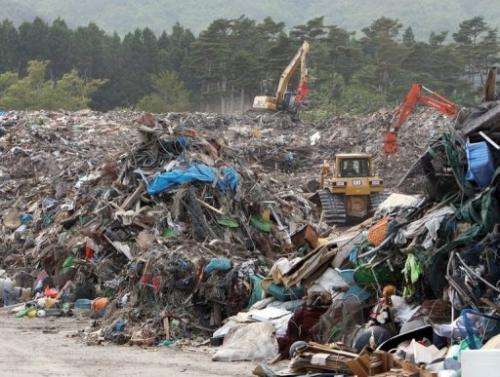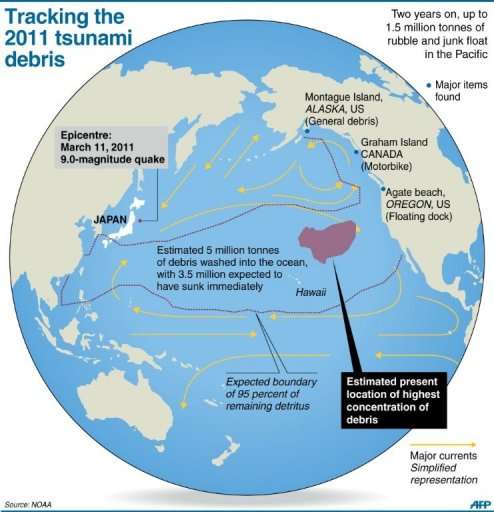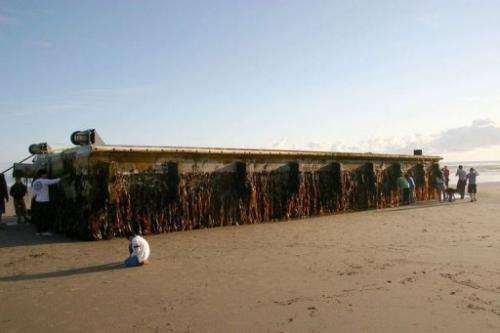Floating tsunami trash to be a decades-long headache

The tsunami that ravaged northeast Japan in March 2011 created the biggest single dumping of rubbish, sweeping some five million tonnes of shattered buildings, cars, household goods and other rubble into the sea.
About three-and-a-half million tonnes, according to official Japanese estimates, sank immediately, leaving some 1.5 million tonnes of plastic, timber, fishing nets, shipping containers, industrial scrap and innumerable other objects to float deeper into the ocean.
Marine experts poring over the disaster say the floating trash adds significantly to the Pacific's already worrying pollution problem.
For many years, and possibly decades, items will be a hazard for shipping, a risk for sea mammals, turtles and birds, a hitchhiking invitation for invasive species and a poorly understood threat to wildlife through plastic micro-particles.
"In a single stroke, the tsunami dumped 3,200 times the amount of rubbish that Japan discharges annually into the Pacific," said Robin des Bois, a French environmental group that is studying the problem.
"In plastic alone, the volume is the equivalent to several decades of accumulated waste in the Atlantic and Pacific."
Early last year, the first debris started to wash up on shores of Oregon, Washington and southern Alaska and the Canadian province of British Columbia.

They were foam and buoys that have "high windage", meaning objects that sit proud of the waves and are easily pushed by the wind.
They were followed by other items that sometimes spoke poignantly of the disaster on the other side of the ocean.
They included a Harley-Davidson motorbike in a container, a football with the owner's name on it, a crewless ship and two massive concrete docks on styrofoam floats.
The docks came from the fishing port of Misawa in Aomori prefecture, yet washed up in Oregon and Washington eight months apart. One dock was rinsed down with bleach as a bio-precaution after it was found to be studded with dozens of foreign species of algae and barnacles.
The docks' odyssey may explain why, contrary to some expectations, there has been no massive landfall of debris.
"NOAA's data suggests that the debris is no longer in a mass or a patch," said Sherry Lippiatt, regional coordinator in California for the US National Oceanic and Atmospheric Administration's marine debris programme.

"Rather, it has spread out across the vast North Pacific Ocean since it was introduced nearly two years ago."
Indeed, exactly where the trash is and how much remains is unclear.
Much may have sunk or become waterlogged, and scattering means there are no more clusters to be monitored by plane or satellite.
Sightings by passing vessels or fishermen, along with computer models, suggest the bulk of slower-moving debris is located north and east of Hawaii.
Simon Boxall of Britain's National Oceanographic Centre pointed to a circular current, called a gyre, that loops slowly around the North Pacific.
"It heads across the Pacific towards North America, goes down alongside the California coast and then comes round, taking about six or seven years to get back to Japan," he said.
"Most of the debris will follow the gyre," eventually getting trapped in the centre of the vortex in the so-called Pacific Garbage Patch between Hawaii and California, he said. "Some of it could stay for the next 30, 40 years."
Debris in the gyre's northern part tends to split off and head towards the coastline of North America, said Boxall.
It means beach walkers are likely to encounter a disturbing but relentless flow of flotsam for years to come.
"Most of it is pretty harmless," reassured Boxall, adding that any radioactive material from the stricken Fukushima nuclear plant was "obviously" an exception.
"Any oils would have been broken down in the open ocean a long time ago, and most of the chemistry will have been dispersed. Big objects, though, may pose a navigational hazard," he said.
A big question mark remains over plastic items that have been degraded to microparticles, Boxall added.
Previous studies on species of North Sea mussels and fish suggest these particles are swallowed by some marine animals and remain in their digestive tracts.
Francois Galgani of France's Ifremer marine research institute said that "absolutely nothing" was known about the risk from nanoparticles, or microparticles that degrade into yet smaller pieces just billionths of a metre across.
"Another problem is the risk of invasive species and debris that has sunk," he said.
"We don't know much about the currents in the deep ocean, but my bet is that there are bound to be places in the depths where the trash is building up."
(c) 2013 AFP




















